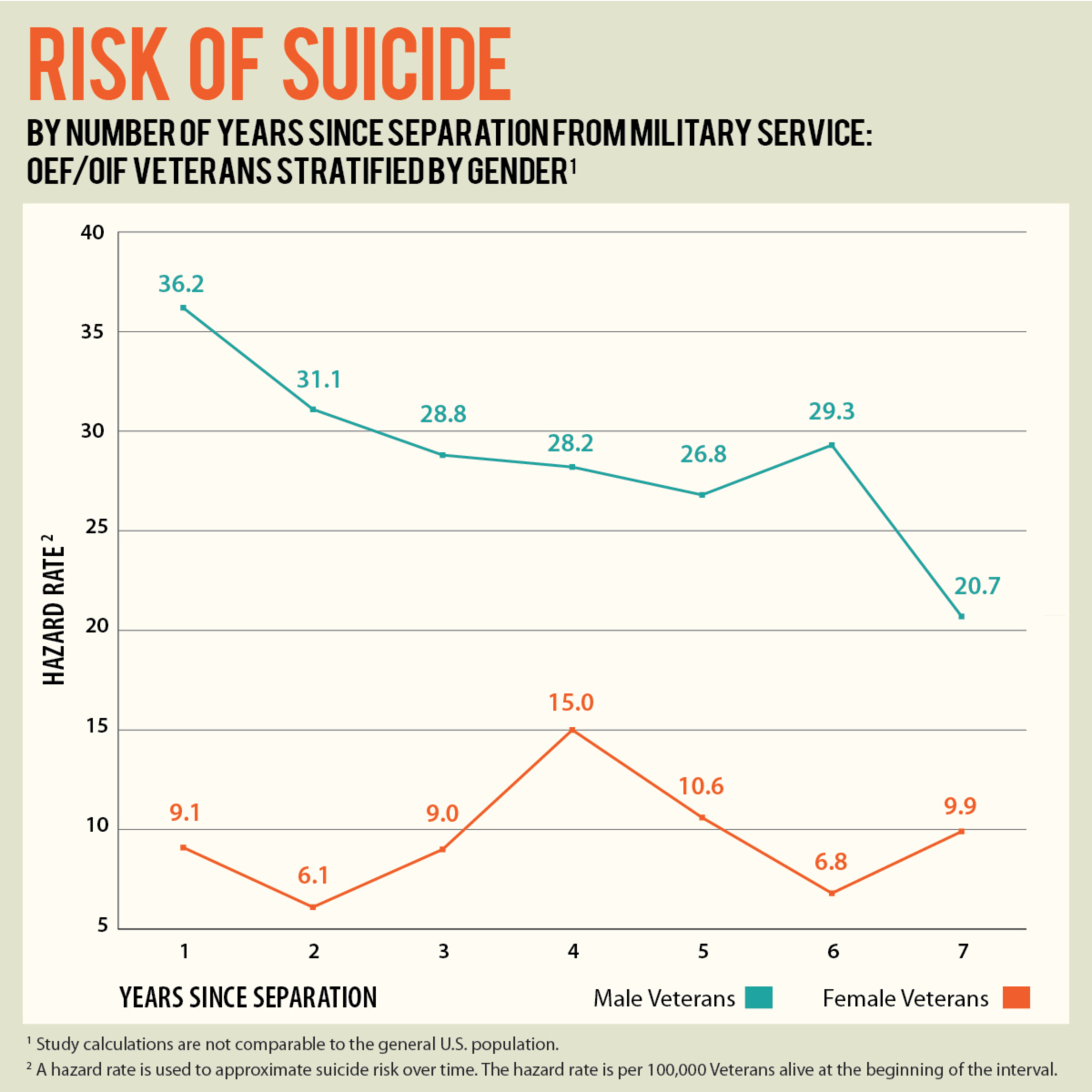Gender Differences in Suicide Risk
According to a study of suicide risk among Operation Enduring Freedom and Operation Iraqi Freedom (OEF/OIF) Veterans, in the seven years following separation from active duty service, the risk of suicide decreased over time for males, but varied over time for females. Overall, suicide risk was higher among male Veterans than females.
Researchers looked at suicide risk among active duty, Reserve, and National Guard Veterans who deployed to OEF/OIF and separated between 2002 and 2011. Read the study abstract.
There were 62 suicides out of 164,333 female Veterans and 1,491 suicides out of 1,237,049 male Veterans. For males, suicides decreased by 6.1% on average per year. Among females the pattern varied, with a hazard rate of 9.1 in the first year following separation, 6.1 in the second year, 15.0 in the fourth year, and 9.9 in the seventh year.
Text version of line graph
Risk of Suicide by Number of Years since Separation from Military Service: OEF/OIF Veterans stratified by Gender
Please note that the study calculations depicted are not comparable to the general U.S. population. The vertical axis of the graph shows the “Hazard Rate” from 0-40 in increments of 5. The hazard rate is used to approximate suicide risk over time. The hazard rate is per 100,000 Veterans alive at the beginning of the interval. The horizontal axis of the graph shows “Years Since Separation” from 1-7 in single year intervals. Data points plotted for male Veterans include, 36.2 after 1 year, 31.1 after 2 years, 28.8 after 3 years, 28.2 after 4 years, 26.8 after 5 years, 29.3 after 6 years, and 20.7 after 7 years. Data points plotted for female Veterans include, 9.1 after 1 year, 6.1 after 2 years, 9.0 after 3 years, 15.0 after 4 years, 10.6 after 5 years, 6.8 after 6 years, and 9.9 after 7 years.
Hazard rate
A hazard rate is used to approximate suicide risk over time. It is a calculation of deaths by suicide per 100,000 Veterans alive for each year since separation from service.
Calculations are not comparable to the general population
The calculations for risk of suicide in this study cannot be compared to the risk of suicide in the general U.S. population. This study used separation from service as the starting point for a period of risk. A similar point in time is not available for the general U.S. population.
Related research
Researchers looked at suicide risk and risk of death among recent Veterans who served in Iraq and Afghanistan between 2001 and 2007 and found that both deployed and non-deployed Veterans had a significantly higher suicide risk compared to the U.S. general population, but deployed Veterans had a lower risk of suicide compared to non-deployed Veterans.
Veterans Crisis Line
Are you a Veteran or concerned about one? The Veterans Crisis Line connects Veterans in crisis and their families and friends with qualified, caring VA responders. Veterans and their loved ones can anonymously:
- Call 1-800-273-8255 and press 1
- Chat online
- Send a text message to 838255
Confidential help is available 24 hours a day, 7 days a week.




















